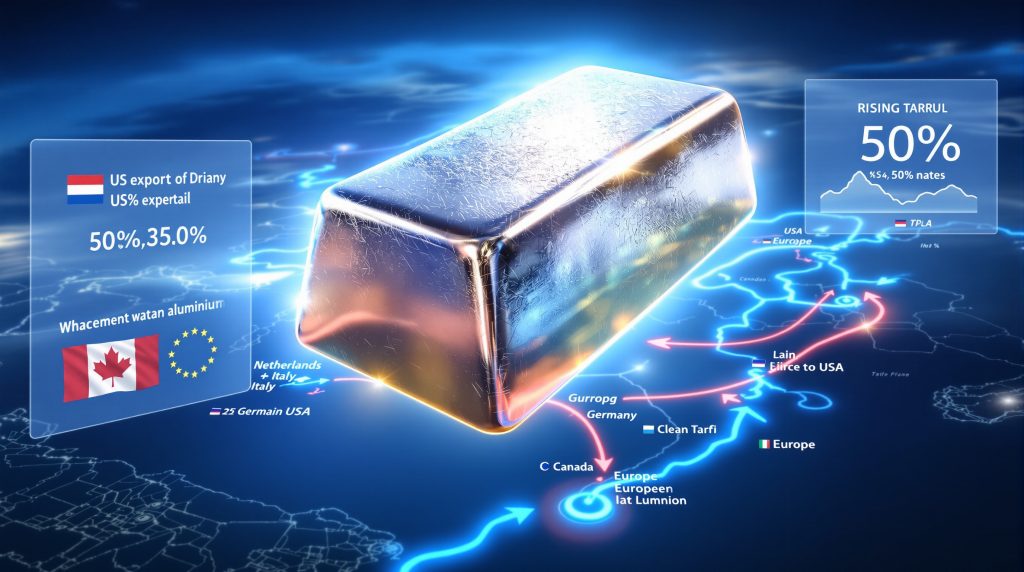Canada's Aluminum Industry Shifts to Europe Amid US Tariff Pressures
In a significant realignment of North American metal trade flows, Quebec's aluminum producers are increasingly redirecting their exports to European markets as punitive American duties make their traditional US market less economically viable. This strategic pivot represents one of the most substantial disruptions to the integrated North American aluminum supply chain in decades, with data showing dramatic shifts in export destinations within just months.
Key Trade Flow Shifts in Numbers
| Period | US Export Share | European Export Share | US Tariff Rate |
|---|---|---|---|
| Q1 2025 | 95% | 0.2% | 25% (from March) |
| Q2 2025 | 78% | 18% | 50% (from June) |
Why Are Canadian Producers Redirecting Aluminum to Europe?
Economic Pressures from Escalating US Tariffs
The redirection of Canadian aluminum exports stems directly from the Trump administration's tariff policies. In March 2025, the US reinstated a 25% tariff on aluminum imports, then doubled this levy to 50% in June. This dramatic increase has made the US market significantly less profitable for Canadian producers, forcing them to seek alternative buyers.
The impact on pricing has been substantial. The US Midwest premium—the amount added to global benchmark prices for delivering aluminum to that region—has surged by 82% since early June 2025. This price distortion has created a unique market dynamic where Canadian producers can achieve better returns by shipping to more distant European markets despite higher transportation costs.
Environmental Policy Advantages in European Markets
Canadian aluminum enjoys a competitive advantage in European markets due to its environmentally friendly production methods. Quebec's smelters operate almost exclusively on hydroelectric power, resulting in some of the lowest carbon footprints in global aluminum production.
This environmental credential has become increasingly valuable as the EU implements its Carbon Border Adjustment Mechanism (CBAM), which favors low-carbon aluminum over products from regions with coal-powered smelters. This policy advantage helps offset the higher shipping costs associated with transatlantic export routes.
Which Companies Are Leading This Export Pivot?
Major Players Adjusting Their Distribution Strategies
Quebec's aluminum industry, which accounts for approximately 90% of Canada's aluminum production capacity, is dominated by three major producers:
-
Rio Tinto Group – Has significantly reduced US shipments and reportedly begun purchasing aluminum from competitors to resell to American customers rather than paying the 50% tariff on its Canadian production
-
Alcoa Corporation – Leveraging the flexibility of its non-contracted production (approximately 30% of Canadian output) to redirect shipments to European markets
-
Aluminerie Alouette Inc. – North America's largest aluminum smelter (40% owned by Rio Tinto) has confirmed a dramatic shift in its export destinations, with European shipments increasing from 4% to 57% over the same period
These strategic adjustments demonstrate how quickly major producers can pivot when faced with significant trade barriers, even in an industry with traditionally stable supply chains.
How Has the European Market Responded to Canadian Aluminum?
Destination Countries and Volume Changes
The redirection of Canadian aluminum to Europe has been concentrated in specific countries:
- Netherlands: Imports from Canada increased to 11,800 tonnes in April-May 2025
- Italy: Received 25,500 tonnes from Canada in the same period
- Germany: Also emerging as a significant destination for redirected Canadian aluminum
This represents a substantial increase compared to historical export patterns, where these countries previously received minimal Canadian aluminum shipments.
Market Reception and Competitive Dynamics
European buyers have welcomed Canadian aluminum due to several factors:
- High quality and consistency of Canadian production
- Favorable carbon footprint compared to alternatives
- Supply diversification away from traditional sources
- Competitive pricing as Canadian producers seek to establish new market relationships
What Are the Long-Term Implications for North American Aluminum Trade?
Disruption of Integrated Supply Chains
The Quebec-US aluminum corridor has historically represented one of North America's most integrated industrial supply chains. The geographic proximity of Quebec's smelters to US manufacturing centers created natural efficiencies that are now being undermined by tariff economic impact.
Jean Simard, head of the Aluminium Association of Canada, described the current situation succinctly: "It's an easy call. You ship anything you can to Europe." This statement reflects the economic reality facing Canadian producers who must prioritize profitability over historical trade relationships.
Potential for Permanent Market Realignment
While some industry experts believe the current trade disruption is temporary, others see potential for longer-term structural changes:
-
Relationship building in Europe: As Canadian producers establish new customer relationships in Europe, some of these connections may persist even if US tariffs impact are eventually reduced
-
Infrastructure investments: Logistical adjustments to support European exports may create more permanent shifts in shipping patterns
-
Contract restructuring: Long-term supply agreements being negotiated now may lock in new trade patterns for years to come
How Are US Aluminum Consumers Affected by These Trade Shifts?
Price Impacts and Supply Challenges
American manufacturers who rely on aluminum inputs are experiencing significant challenges:
- Higher input costs due to tariff-inflated prices
- Potential supply constraints as traditional Canadian imports decrease
- Competitive disadvantages compared to manufacturers in tariff-free regions
The US Midwest premium's 82% increase since June 2025 directly translates to higher costs for American manufacturers of everything from beverage cans to automotive components.
Adaptive Strategies by US Buyers
US aluminum consumers are developing various strategies to manage the new market reality:
- Seeking alternative suppliers from tariff-exempt countries
- Absorbing higher costs and potentially passing them to consumers
- Exploring substitution of aluminum with alternative materials where feasible
- Lobbying for tariff exemptions or modifications
What Does Quebec's Aluminum Export Shift Tell Us About Global Trade Dynamics?
Case Study in Trade Policy Consequences
The redirection of Quebec's aluminum exports provides a clear example of how targeted trade policies can have broader and sometimes unintended consequences:
-
Trade diversion effects: Rather than stimulating domestic US production as intended, tariffs impact markets by primarily redirecting Canadian exports to Europe
-
Regional integration fragility: Even deeply integrated North American supply chains can fragment quickly when faced with significant policy barriers
-
Environmental policy influence: The EU's carbon border adjustments are creating new competitive advantages based on production methods rather than just price
Global Aluminum Market Rebalancing
The shift in Canadian exports is contributing to a broader rebalancing of global aluminum flows:
- European markets receiving more North American aluminum than historically normal
- Potential opportunities for other producers to fill the gap in US supply
- Price disparities between regional markets creating arbitrage opportunities
How Might Future Policy Changes Affect This New Trade Pattern?
Scenarios for US-Canada Aluminum Trade
Several potential developments could influence the current export redirection:
-
Tariff adjustments: Any reduction in US aluminum tariffs would likely prompt Canadian producers to reconsider their European pivot
-
Negotiated exemptions: Targeted exemptions for specific Canadian producers or aluminum grades could partially restore traditional trade patterns
-
Countervailing measures: European responses to increased aluminum imports could affect the sustainability of the current shift
-
Carbon policy evolution: Further development of carbon border adjustments globally could create new competitive dynamics
Industry Adaptation Strategies
Quebec's aluminum industry is pursuing multiple strategies to navigate the current trade environment:
- Diversifying export markets beyond just Europe and the US
- Developing higher-value aluminum products that can better absorb tariff costs
- Exploring production adjustments to optimize for the new market reality
- Engaging in trade policy advocacy through industry associations
What Are the Environmental Implications of Redirected Aluminum Flows?
Carbon Footprint Considerations
The redirection of aluminum exports has mixed environmental implications:
- Increased shipping distances: Transporting aluminum across the Atlantic rather than to nearby US markets increases transportation emissions
- Production method recognition: European markets may place higher value on Quebec's low-carbon production methods
- Global emissions impact: If Quebec's hydropower-produced aluminum displaces coal-powered production elsewhere, net global emissions could decrease despite longer shipping routes
The significant role of aluminum in energy transition metals makes these environmental considerations particularly important as governments worldwide pursue decarbonization goals.
FAQ: Canadian Aluminum Export Shifts
Why is Canadian aluminum production concentrated in Quebec?
Quebec's abundant hydroelectric resources provide reliable, low-cost, and low-carbon electricity, which is essential for the energy-intensive aluminum smelting process. This natural advantage has made the province a global hub for aluminum production, accounting for approximately 90% of Canada's total capacity.
How quickly can aluminum producers change export destinations?
Major producers can redirect significant portions of their exports within weeks or months, particularly for non-contracted production. Approximately 30% of Canadian aluminum production is not tied to long-term contracts, allowing for relatively rapid market pivots when economic conditions change.
Will European markets remain a viable alternative to US exports long-term?
While Europe offers a temporary refuge from US tariffs, the sustainability of this export shift depends on several factors, including European demand growth, competition from other producers, potential European trade policies, and any future changes to US tariffs.
How do transportation costs affect the economics of shipping to Europe versus the US?
Shipping aluminum to Europe incurs higher transportation costs compared to the US market. However, the 50% US tariff creates such a significant price disadvantage that European exports remain economically viable despite these additional costs. The exact breakeven point varies based on specific market conditions and shipping rates.
Further Exploration:
Readers interested in learning more about global aluminum trade dynamics can also explore related educational content from Bloomberg News, which offers additional perspectives on how tariff policies are reshaping international metal markets. Additionally, the ongoing US-China trade war continues to influence broader metals markets and supply chain decisions across the globe.
Looking to Capitalize on Major Mineral Discovery Opportunities?
Stay ahead of the market with Discovery Alert's proprietary Discovery IQ model, which provides real-time notifications when significant mineral discoveries are announced on the ASX. Explore why historic discoveries can generate substantial returns by visiting Discovery Alert's dedicated discoveries page and begin your 30-day free trial today.




